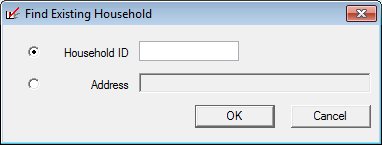
Contents Show
The Find Existing Household screen is used to search for a household and display the results of the search in the Households data grid on the Select Existing Household screen.

Find Existing Household screen
|
|
Interface InitializationUpon initial display of the screen, the following occurs:
|
Unless otherwise stated below, all controls on the Find Existing Household screen are visible and enabled when:
The screen is active.
If one or more special conditions exist that affect a control on the Find Existing Household screen, the condition(s) are documented for that specific control below.
Select the Household ID radio button to indicate a search by household ID, then enter the household ID of an existing household in the Household ID masked edit box.
The radio button is selected as the default.
The masked edit box accepts the entry of alphabetic and numeric characters only.
The control is enabled when:
The Household ID radio button is selected.
Special characters are not allowed. The mask on the masked edit box is "########". The masked edit box initially defaults to blank.
When the Household ID radio button is selected, the Address radio button is cleared and text box is cleared and disabled.
Select the Address radio button to indicate a search by address, then enter the residence address of an existing household in the Address masked edit box.
The text box allows the entry of alphabetic, numeric, and special characters.
The control is enabled when:
The Address radio button is selected.
Special characters are limited to the following: period (.), pound sign (#), dash (-), forward slash (/), and apostrophe ('). Alphabetic characters are converted to upper case when entered. The maximum number of characters that can be entered in the text box is fifty (50) characters; however, when data is sent to the EBT host using the Universal Interface specifications, only the first thirty (30) characters of the address will be transmitted.
When the Address radio button is selected, the Household ID radio button is cleared and masked edit box is cleared and disabled.
Click the OK button to process the screen.
It is the default button for the screen, unless otherwise noted.
It does not have a mnemonic. Its keyboard shortcut is the Enter key.
A search is performed and the Select Existing Household displays when the button is clicked.
Upon clicking the OK button when the Household ID radio button and masked edit box are valued, a search for an existing household with the Household ID equal to the value specified in the Household ID masked edit box is performed. If the system finds a match, it will select the appropriate entry in the Households data grid on the Select Existing Household screen and close this screen. If the system does not find a match, the system displays a standard error message (E0050).
Upon clicking the OK button when the Address radio button and text box are valued, a search for an existing household with a residence equal to the value specified in the Address text box up to the number of characters specified is performed. If the system finds a match, it will select the appropriate entry in the Households data grid on the Select Existing Household screen and exit this screen. If the system does not find a match, the system displays a standard error message (E0050).
It does not have a mnemonic. Its keyboard shortcut is the Esc (escape) key.
Depending on which screen originally called the Find Existing Household screen, one of the following screens displays when the button is clicked:
If data can be validated and saved on the screen, the following processes occur when the screen is processed:
A process to check for required controls as identified in the Data Map below is performed.
A process to check for valid entries as identified individually for each applicable control in Screen Elements above is performed.
A process to check for edits and cross edits as identified for each applicable control in Screen Elements above is performed.
If any checks or processes fail, a standard error message displays.
If no data can be validated and saved on the screen:
No cross edits are performed.
All values are considered legitimate.
No data is written to the database.
The Data Map defines the values saved for all controls on the screen. If available, any additional notes or comments are displayed in the Notes column.
|
Control Label |
Required |
Table |
Column |
Notes |
|
Search Criteria |
X |
· |
· |
· |
|
Software Version: 2.40.00